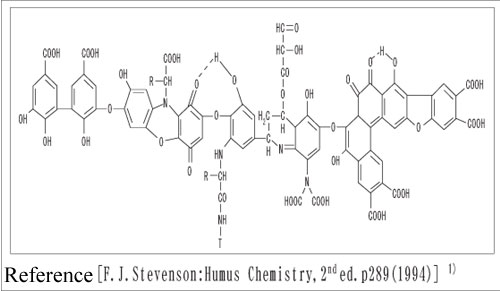Zeta potential and particle size measurement of humic acid-heavy metal complex
2.About humic acid
Humin substances include soil (farmland, forests, mountains), peat, coal, oil, water (seawater, river water, lake water, natural water, groundwater, drainage, river mouth water), sediments (seabed, lake bottom) and so on, and they are moving. They are called terrestrial humic acid, river humic acid, and marine humic acid, respectively. In this way, humic acid is an organic substance that exists in large quantities on the earth and has various effects on the global environment. However, the humic substance is a mixture, and it is said that the structure differs depending on the collection location, and each has characteristic properties.
1) Classification of humic substances
Humic substances is defined by the International Humic Substances Society (IHSS) as follows. "A fraction that obtained by extracting soil with an alkali such as NaOH, or that adsorbed on XAD resin with natural water and eluted with a diluted alkaline aqueous solution, and this fraction is further precipitated with acid. The fraction that is precipitated or isn’t precipitated with an acid are called humic acid and fulvic acid, respectively.
”Fulvic acid is a substance that dissolves well in all solutions regardless of pH and is present in water systems such as rivers, lakes, seawater, and groundwater. It occupies most of the humin substances, and accounts for 40% of the organic substances dissolved in the river. Humic acid is insoluble in water when it is strongly acidic with a pH 2 or less, but it is soluble in strong alkalis. It has a higher molecular weight and darker color than fulvic acid, and is abundant in soil, sediments, peat, etc., and accounts for most of the organic carbon component.
2) Structure of humic substances *
The main constituent elements are carbon, oxygen, hydrogen and nitrogen, also including sulfur and phosphorus. The ratio of carbon and oxygen is high, accounting for ~50% and ~30% (wt%) of the total. Since humic substance is a mixture, the average molecular weight and molecular weight distribution are being investigated. The average molecular weights reported vary greatly but are said to be around 500 to tens of thousands. Its molecular structure is not clear because of its peculiarity of the collection area and its complexity, the typical chemical structure of humic acid is shown in Fig. 1.
* (Note) XAD resin
A synthetic adsorbent that is a copolymer of styrene or acrylic and divinylbenzene and has an MR structure (Macro Reticular structure). They are white opaque spherical particles similar to ion exchange resins. Unlike an ion exchange resin, it does not have a functional group, so it is chemically extremely stable and can be used in organic solvents such as alcohol and acetone.

Figure 1. Conceptual diagram of humic acid
3) Applied fields of humic substances
(1) Application to agriculture
It is said that the agricultural field is the most advanced in applied research of humic substances. Although it is often not well understood from a theoretical point of view, the surface activity of humic substances promotes the absorption of water and nutrients in crops. In addition, it promotes the retention and transportation of crop-required elements in soil because it has a complex-forming action with metals and the ability to dissolve insoluble metals.
(2) Application to the fisheries
The surface-active action and metal complex forming action of humic substances can be used to improve water quality.
(3) Application to the livestock industry
By mixing humic substances and their aqueous solutions with feed, it is effective in improving the meat quality of livestock, improving disease resistance, and suppressing manure odor.
(4) Application to health-related
Humic substances is not a drug or quasi-drug, but taking an aqueous solution of humic substances or applying it to the skin is a common usage, and many examples of improvement have been reported.
4) Research institute for humic substances
The international humic substances society is a global research institute for humic substances. In Japan, various studies are being conducted by the Japan Society for the Society of Rot and Vegetables (a member of 71 organizations such as national, public and private universities, research institutes, major corporate research institutes, and private-sector rot and plant researchers) based on the World Society for the Study of Rot and Plant. The Annual Meeting of the Japanese Society of Humus is held once a year.
5) Adsorption of metal to humic acid
It is well known that humic substances forms a complex with heavy metals as described above, and it is expected to be used for soil improvement and water quality improvement in the environmental field. This time, we have taken up humic substances, which is abundant in soil, sediments, and peat among the humic substances. As shown in Fig. 2, the absorption performance of various heavy metals to humic acid varies depending on the pH, but it has been reported that it increases in the order of Pb, Cr, Cu> Cd, Zn, Ni> Co, Mn. 2)
.jpg)
Figure 2. pH dependence of the amount of heavy metal adsorbed on humic acid of 5 × 10-4 mol / L 2)
In addition, from the structure shown in Fig. 1, it has many carboxyl groups and is negatively charged. It causes bonding with cations of various heavy metals easily and forms a complex. Zeta potential and particle size of the complex were measured, and the difference of adsorption performance was considered with their results.
|
References
|
1) | Stevenson,F.J.:Humic Chemistry: Genesis, Composition,Reactions, 2nd ed., John Wiley Sons Canada (1994) |
| 2) | Kerndorf,H.,Schnizer, M.: Geochimica et Cosmochimica Acta, 44, 1701-1708 (1980) |


 Close
Close

